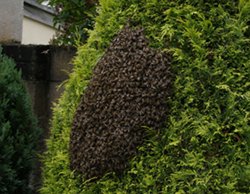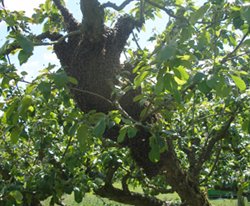Dublin Beekeeping Services
Honeybee & Swarm Removal Service
Honey Bee Swarms
What is a honey bee swarm?

Swarm on a bush
A swarm of honey bees may contain from 12,000 to 30,000 bees including, workers, drones, and a queen and is an instinctive and natural part of the annual reproduction life cycle of a honey bee colony and is he wat for the colony to reproduce itself. When a bee colony becomes too large it divides by swarming.
Here in Dublin the swarming season is usually between early May to mid July but on occasions colonies may swarm at other times. Warmer weather, combined with an abundance of nectar and pollen, stimulate the colony to increase in population. When conditions are right in the hive the old queen or a young newly hatched queen leaves with many of the workers in a huge cloud of bees.
Swarms usually emerge from their colonies between 10.00 am and 2.00 pm on warm sunny days. They have filled up with honey and are searching for a new home and so are normally docile and not interested in humans.
The swarm of honey bees will then all temporarily cluster, at one location, such as on a branch of a tree or bush. The cluster of bees range in size from the size of a large grapefruit to basketball size and sometimes larger. Scout bees are then sent out in search of a suitable home, such as a hole in a tree or a building.
The existence of a swarm can take a few hours to several days, till a suitable cavity is found. When a suitable home is found the swarm moves as a group to that new site.

Honey bee queen
What makes a honey bee colony swarm?
The presence of an old or failing queen, overcrowding, congestion in the hive is factors which cause colonies to swarm. The presence of an old queen and a mild winter also contribute to the development of the swarming impulse.
Swarming can be controlled by a skilled beekeeper; however, not all colonies live in hives and have a human caretaker.
When do honey bees swarm?
The tendency to swarm is usually greatest when bees increase their population rapidly in late spring and early summer. In Dublin, this would be in late April to mid July.
Are honey bee swarms dangerous?
No - honey bees exhibit defensive behaviour only in the vicinity of their hive.

Swarm in an apple tree
Defensive behaviour is needed to protect their young and food supply. A honey bee swarm has neither young nor food stores to protect and will not exhibit defensive behaviour unless unduly provoked.
Although they can be unnerving to see, swarms are not generally dangerous. Bees in swarms will only sting if they are harassed. In fact, while they are swarming honeybees are in their most gentle state because they do not have a hive to defend.

Swarm in the air

Native bee